Discover the beauty and sustainability of Palm Leaf Plates, Nature’s Tableware. Perfect for eco-conscious consumers, these biodegradable and compostable plates offer a stylish, durable solution for reducing environmental impact. Embrace a greener lifestyle with palm leaf plates.
The Problem with Traditional Disposable Tableware
Environmental Impact and Pollution
One of the most pressing issues with traditional disposable tableware is its contribution to environmental pollution. Plastic tableware, for instance, is often not recycled, ending up in landfills or, worse, in oceans and other natural habitats. Here, it can take hundreds to thousands of years to decompose, releasing toxic chemicals into the environment and posing a threat to wildlife. Animals can ingest these plastics, mistaking them for food, which can lead to injury or death. Moreover, the degradation of plastics in the ocean contributes to microplastic pollution, which affects water quality and marine life and eventually enters the human food chain.
Paper tableware, while potentially less harmful than plastic, still has its drawbacks. The production of paper plates requires significant amounts of water and wood, contributing to deforestation and water pollution. Although paper plates are biodegradable, if they are coated with plastic or contaminated with food waste, their decomposition rate slows down significantly, and they may not be accepted by recycling facilities.
Carbon Footprint
The production and disposal of disposable tableware also have a considerable carbon footprint. The manufacturing processes for plastic and paper goods are energy-intensive, contributing to greenhouse gas emissions. Additionally, the transportation of these single-use items, from production facilities to distribution centers, to retailers, and ultimately to consumers, further increases their carbon footprint.
Waste Management Challenges
Disposable tableware contributes significantly to the global waste problem. Many municipalities struggle with the increasing volumes of waste generated by single-use items, which strain landfill capacities and waste management systems. The disposal of these items not only occupies valuable land space but also requires resources for their management, including collection, transportation, and processing.
Social and Economic Considerations
Beyond environmental impacts, there are social and economic considerations to the widespread use of disposable tableware. The reliance on single-use items perpetuates a throwaway culture that undervalues sustainability and resource conservation. Moreover, managing the waste from disposable tableware incurs significant costs for local governments and, by extension, taxpayers. Investing in sustainable alternatives could not only mitigate environmental harm but also promote economic opportunities in green industries.
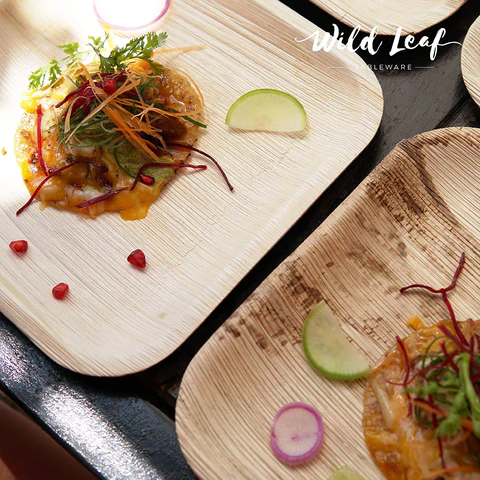
The Rise of Palm Leaf Plates
Natural and Sustainable Origin
Palm leaf plates are crafted from the fallen leaves of the Areca palm tree, an abundant natural resource that does not necessitate the tree’s harm or destruction. This method of production harnesses a sustainable cycle of renewal, where fallen leaves, which would otherwise decompose and go to waste, are given a new life. The use of these naturally shed leaves ensures that the production of palm leaf plates has a minimal environmental footprint, contributing significantly to their popularity among environmentally conscious consumers.
Eco-Friendly Attributes
The biodegradability and compostability of palm leaf plates stand in stark contrast to the non-biodegradable nature of traditional plastic disposables. These plates decompose naturally within a few months when composted, turning into nutrient-rich soil and thereby completing a natural cycle that contributes positively to the environment. This attribute significantly reduces the waste problem associated with single-use tableware, offering a guilt-free convenience for consumers looking to minimize their ecological impact.
Aesthetic and Practical Appeal
Beyond their environmental benefits, palm leaf plates possess a unique aesthetic appeal, with each plate featuring a distinct pattern and texture that speaks to its natural origin. This rustic charm has made them a favored choice for events like weddings, outdoor parties, and eco-friendly restaurants seeking to offer an authentic and environmentally responsible dining experience. Additionally, their sturdy construction makes them capable of handling a variety of foods, further enhancing their practicality and appeal.
Market Response and Consumer Demand
The growing demand for palm leaf plates is a direct response to a more informed and environmentally conscious consumer base. As people become more aware of the environmental crises facing our planet, there is a growing preference for products that align with sustainable living principles. This shift in consumer behavior is reflected in the rising popularity of palm leaf plates, which are seen as a tangible way to reduce one’s environmental footprint.
Innovative Marketing and Social Media Influence
The role of innovative marketing strategies and the power of social media have been instrumental in the rise of palm leaf plates. Through engaging storytelling and visually appealing content, brands have been able to highlight the environmental benefits and unique aesthetic of palm leaf plates, reaching a wide audience. Social media platforms have become showcases for eco-friendly products, with influencers and environmentally conscious users sharing their experiences and thus further driving interest and adoption.
Global Environmental Awareness
The global push for sustainability has been a key driver in the rise of palm leaf plates. As awareness of global environmental issues such as plastic pollution, deforestation, and climate change increases, there is a collective movement towards adopting more sustainable lifestyles. Palm leaf plates, with their minimal environmental impact and biodegradability, embody the principles of this movement, offering a simple yet effective solution to the problem of disposable tableware waste.
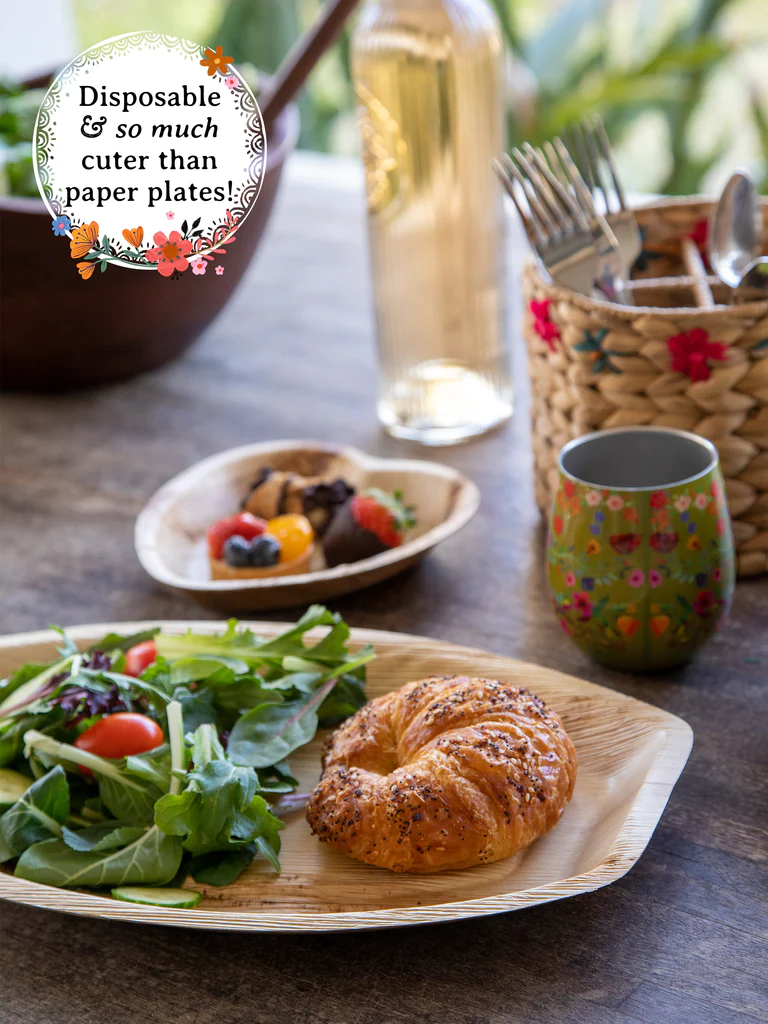
Why Palm Leaf Plates?
Environmental Sustainability
Palm leaf plates are made from the naturally fallen leaves of the Areca palm tree, ensuring that no trees are cut down in their production. This sustainable sourcing method significantly minimizes the environmental impact associated with the harvesting of raw materials. Moreover, since the plates are completely natural and free from chemicals, they offer an eco-friendly alternative that contributes positively to the health of the planet.
Biodegradability and Compostability
Unlike plastic or even paper plates that can take decades or more to decompose, palm leaf plates are 100% biodegradable and compostable. They break down naturally within a few months in a composting facility or a home compost bin, turning into nutrient-rich soil without leaving any toxic residue. This rapid decomposition cycle helps reduce landfill waste, making palm leaf plates an ideal choice for those looking to minimize their environmental impact.
Durability and Versatility
Despite their natural composition, palm leaf plates are remarkably sturdy and can handle a wide range of foods, including hot, wet, and oily dishes, without bending, breaking, or leaking. This makes them a practical and reliable option for all types of occasions, from casual gatherings to formal events. Their versatility and strength ensure that they are not just environmentally friendly but also highly functional.
Unique Aesthetic Appeal
Each palm leaf plate has a distinctive look, with natural patterns and textures that add a rustic charm to any meal. This unique aesthetic appeal sets them apart from the uniform appearance of traditional disposables, making them a stylish choice for weddings, parties, and other events where presentation matters. The natural beauty of palm leaf plates can enhance the dining experience, adding an element of sophistication and eco-consciousness to the table setting.
Safe and Chemical-Free
Palm leaf plates are produced using a simple process that involves cleaning, heat pressing, and trimming the leaves into shape, without the need for any chemicals or synthetic additives. This natural production method ensures that the plates are safe for serving food, free from toxins and harmful substances that can leach into food from plastic tableware.
Contribution to Sustainable Livelihoods
The production of palm leaf plates supports sustainable livelihoods in rural areas where Areca palm trees grow. By providing a use for fallen leaves that would otherwise go to waste, this industry helps create jobs and economic opportunities in these communities, contributing to their development and well-being.
Global Trend Towards Eco-Friendly Products
As consumers become more environmentally conscious, the demand for products that are not only convenient but also sustainable is on the rise. Choosing palm leaf plates aligns with this global trend, allowing individuals and businesses to demonstrate their commitment to eco-friendly practices and make a positive impact on the environment.
How Are Palm Leaf Plates Made?
Collection of Fallen Leaves
The first step involves collecting the fallen leaves of the Areca palm tree. These leaves are naturally shed by the trees and collected without harming the plant or the surrounding environment. This method ensures that the production of palm leaf plates is sustainable and does not contribute to deforestation or the depletion of natural resources.
Cleaning and Sanitizing
Once collected, the leaves undergo a thorough cleaning process. They are washed to remove dirt and any other natural debris. After washing, the leaves are sanitized using natural, eco-friendly methods to ensure they are safe for use in serving food. This step is crucial for maintaining the hygiene and quality of the final product.
Heat Pressing
After cleaning and sanitizing, the leaves are then dried and subjected to a heat-pressing process. In this step, the leaves are placed between two heated molds that press them into the desired shape and size. The heat and pressure not only shape the leaf but also sterilize it further, ensuring that the plates are safe for food contact. This process is entirely mechanical and does not involve the use of any chemicals, making the plates 100% natural and eco-friendly.
Trimming and Finishing
Once pressed into shape, the edges of the plates are trimmed to ensure uniformity and remove any rough edges. This finishing touch enhances the aesthetic appeal of the plates, making them suitable for various settings, from casual to formal. The trimming process is often done manually, ensuring attention to detail and quality control.
Quality Checks
Before packaging, the palm leaf plates undergo stringent quality checks to ensure they meet certain standards of strength, durability, and hygiene. Plates that do not meet these criteria are recycled or composted, ensuring minimal waste in the production process.
Packaging
Finally, the plates are packaged for distribution. The packaging materials used are often eco-friendly, aligning with the sustainable nature of the product itself. The plates are then ready to be shipped to retailers or directly to consumers, providing an eco-conscious alternative to traditional disposable tableware.
Sustainable and Eco-Friendly Impact
The entire process of making palm leaf plates is designed to be as environmentally friendly as possible. It utilizes a renewable resource without causing harm to the trees, employs a chemical-free production method, and results in a product that is completely biodegradable and compostable. Moreover, this industry supports the economy of rural communities where these palm trees grow, providing sustainable livelihoods to local workers.
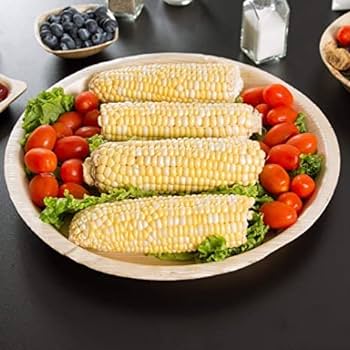
Comparing Palm Leaf Plates to Other Eco-friendly Alternatives
Palm Leaf Plates vs. Bamboo Tableware
Bamboo tableware is another popular eco-friendly option, made from one of the fastest-growing plants on Earth. Bamboo’s rapid growth and ability to regenerate after cutting make it a highly renewable resource. However, converting bamboo into tableware often involves more energy-intensive processes compared to the simple, mechanical pressing used for palm leaf plates. Additionally, bamboo products sometimes require binding agents or chemicals to shape and finish them, which may not be as eco-friendly as the completely natural, chemical-free process of making palm leaf plates.
Palm leaf plates, on the other hand, are made from naturally fallen leaves, which means their production does not require the cutting down of trees or plants. This aspect might appeal more to those looking to minimize their environmental impact even further. Moreover, the unique textures and patterns of palm leaf plates offer a distinctive aesthetic that bamboo tableware, with its more uniform appearance, might not match.
Palm Leaf Plates vs. Compostable Plastics
Compostable plastics, often made from plant materials like corn starch, present a modern solution to the problem of plastic pollution. These products are designed to break down in industrial composting facilities within a specific timeframe. However, their compostability is conditional, requiring specific conditions that are not always accessible to the average consumer. If not properly composted, these plastics can remain in the environment for a long time, failing to address the issue of waste effectively.
Palm leaf plates decompose naturally and can be composted at home, making them a more straightforward and accessible option for reducing waste. They do not require industrial composting facilities to break down, making them a more practical choice for eco-conscious consumers without access to such facilities.
Palm Leaf Plates vs. Edible Tableware
Edible tableware is a novel concept where the tableware itself can be eaten after use, leaving no waste behind. This option is innovative and fun, offering a unique way to reduce waste. However, the practicality and applicability of edible tableware are limited by factors such as taste compatibility with different foods, durability, and storage requirements.
Palm leaf plates offer greater versatility and durability, suitable for a wide range of foods and occasions. While they might not be edible, their biodegradability ensures that they still provide an environmentally friendly solution without the need for special conditions or considerations.
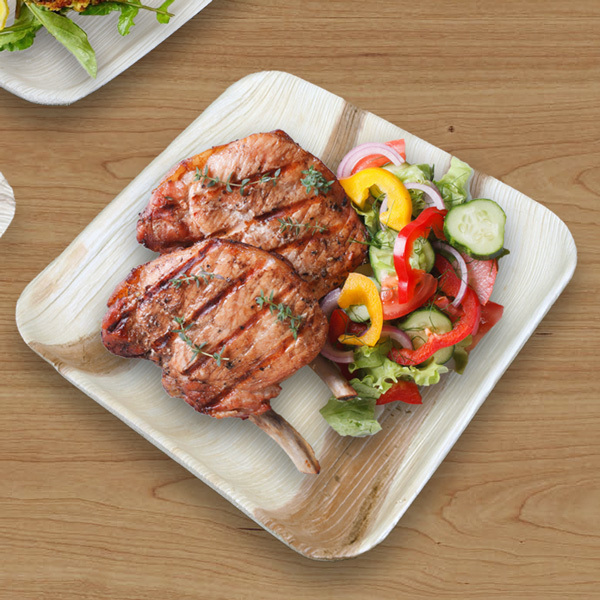
Using Palm Leaf Plates
At Home
Palm leaf plates can be a great addition to your daily life, especially for casual meals, barbecues, or family gatherings. Their natural, rustic look can add a unique touch to your dining table, while their compostability means you can enjoy the convenience of disposable plates without the environmental guilt. After use, simply compost them in your home composting system, where they will break down and contribute to nutrient-rich soil.
Events and Occasions
For event organizers or individuals planning a wedding, party, or any special occasion, palm leaf plates offer an eco-chic alternative to conventional disposables. They are particularly suitable for outdoor, rustic, or eco-themed events. Not only do they reduce cleanup time, but they also demonstrate a commitment to sustainability, leaving a lasting impression on guests. Plus, their sturdy design can elegantly accommodate a wide range of dishes, from appetizers to main courses.
Catering and Food Services
Restaurants, caterers, and food service providers looking to adopt greener practices can benefit from switching to palm leaf plates. They are ideal for takeaways, food stalls, and outdoor dining settings, where durability and environmental impact are key considerations. Palm leaf plates can withstand various food types without getting soggy or leaking, ensuring a positive customer experience. Furthermore, using such eco-friendly tableware can enhance a brand’s image, appealing to the growing market of environmentally conscious consumers.
Care and Maintenance
While palm leaf plates are designed for single-use, they can sometimes be gently wiped clean and reused for dry or light snacks, depending on their condition after the initial use. However, it’s important to note that they are not suitable for washing in a dishwasher or soaking in water, as this would compromise their structure and integrity.
Disposal
The best way to dispose of palm leaf plates is by composting them. They are completely biodegradable and compostable, breaking down into nutrient-rich soil within a few months under the right conditions. This makes them a zero-waste option, as they return to the earth without leaving harmful residues. If you do not have access to a composting facility or a home compost bin, check with your local waste management services to see if they can be included in green waste collections.
Educating Others
Using palm leaf plates also presents an opportunity to educate others about sustainable living practices. By choosing eco-friendly tableware, you can inspire family, friends, and customers to consider their environmental impact and explore greener alternatives in their own lives.
The Future of Sustainable Tableware
Continued Innovation and Material Advancements
Innovation is key to the future of sustainable tableware. Researchers and manufacturers are continuously exploring new materials and processes to create products that are not only environmentally friendly but also practical for everyday use. Materials such as agricultural waste, algae, and mycelium are being investigated for their potential in producing durable, compostable tableware. These advancements promise to expand the range of options available, making sustainable tableware more accessible and appealing to a broader audience.
Increased Consumer Demand
As awareness of environmental issues grows, so does consumer demand for products that align with a sustainable lifestyle. This trend is expected to accelerate, with more people seeking out alternatives to traditional plastics and disposables. Businesses and brands that offer eco-friendly tableware options, like palm leaf plates, will likely see increased interest and loyalty from consumers who prioritize sustainability. This shift in consumer behavior will drive further innovation and availability of sustainable tableware products.
Regulatory Support and Policies
Government policies and regulations play a crucial role in promoting the use of sustainable tableware. Many regions are already implementing bans on single-use plastics, which opens the market for eco-friendly alternatives. As more governments recognize the importance of reducing waste and promoting sustainability, we can expect to see increased support for the production and distribution of sustainable tableware, including incentives for companies that innovate in this space and stricter regulations on non-compostable disposables.
Integration of Circular Economy Principles
The concept of a circular economy, where resources are reused and recycled to minimize waste, is gaining traction. Sustainable tableware fits perfectly within this model, as products like palm leaf plates are designed to be composted and returned to the earth. The future will likely see a greater integration of circular economy principles into the production and lifecycle of tableware, with a focus on reducing environmental impact at every stage, from manufacturing to disposal.
Education and Awareness Campaigns
Education plays a vital role in the adoption of sustainable practices. As more people become informed about the environmental benefits of using sustainable tableware, the shift towards eco-friendly alternatives will accelerate. Schools, businesses, and organizations can contribute to this shift by promoting the use of sustainable tableware through educational campaigns and initiatives, showcasing the positive impact of such choices on the environment.
Global Accessibility
Currently, access to sustainable tableware varies significantly across different regions. The future of sustainable tableware includes efforts to make these products more globally accessible, ensuring that communities around the world can benefit from eco-friendly alternatives. This involves addressing cost barriers, distribution challenges, and local regulations to enable wider adoption of sustainable tableware solutions.

Conclusion
Palm leaf plates represent a significant step forward in our journey towards sustainable living. By opting for eco-friendly tableware, we not only reduce our environmental footprint but also support a more sustainable economy. Let’s embrace nature’s tableware and make a positive impact on our planet.
FAQs
- Are palm leaf plates safe for all types of food? Yes, palm leaf plates are safe for hot, cold, wet, or oily foods, making them versatile for various culinary needs.
- Can palm leaf plates be microwaved? Palm leaf plates can handle moderate heat, making them suitable for short periods in the microwave, although it’s best to refer to the manufacturer’s guidelines.
- How long do palm leaf plates take to compost? Palm leaf plates typically decompose within a few months in a home composting system, much faster than plastic alternatives.
- Are palm leaf plates more expensive than traditional disposable plates? While palm leaf plates may have a higher upfront cost, their environmental benefits and unique aesthetic value provide greater overall value.
- How can I dispose of palm leaf plates responsibly? Palm leaf plates can be composted at home or in a commercial composting facility, turning them back into soil without contributing to landfill waste.
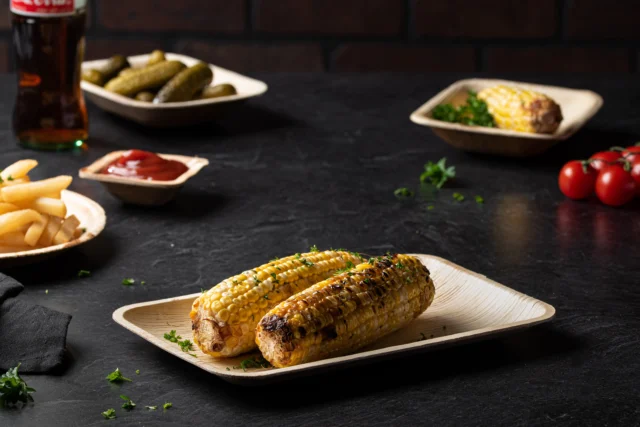


MOST COMMENTED
Animal-Based Proteins / Casein Protein / Dietary Protein / High-Protein Diets / Pea Protein / Plant-Based Proteins / Protein / Protein Deficiency / Protein Supplements / Proteins / Whey Protein / Whey Proteins
Is Protein Powder Safe for Teenagers and Children?
Animal-Based Proteins / Casein Protein / Dietary Protein / High-Protein Diets / Pea Protein / Plant-Based Proteins / Protein / Protein Deficiency / Protein Supplements / Proteins / Whey Protein / Whey Proteins
Unlock the Power of Proteins for Optimal Gut Health
Animal-Based Proteins / Casein Protein / Dietary Protein / High-Protein Diets / Pea Protein / Plant-Based Proteins / Protein / Protein Deficiency / Protein Supplements / Proteins / Whey Protein / Whey Proteins
Pea Proteins: The Best Plant-Based Protein Alternative?
Multivitamin
Total Health: Multivitamin for Active Lifestyles
Multivitamin
WellnessFusion: Complete Multivitamin Support
Dietary Supplement
Revitalize Your Health: The Magic of Red Yeast Rice Capsules
Foot care / Foot Health
Revitalize Your Foot Care Routine: Essential Tips for Optimal Foot Health
Foot Problem / Diabetics / Foot Health
Diabetics: Mastering Footwear Selection for Enhanced Foot Health and Ultimate Comfort
Exercises and Footwear Tips for Hammertoe Relief / Foot care / Foot Health / Foot Pain / Foot Problem / Hammertoes
Unlock Effective Exercises and Footwear Tips for Hammertoe Relief
Hammertoes / Foot Health / Foot Pain / Foot Problem
Unlock Relief: Essential Guide to Hammertoes Causes, Symptoms, and Treatments